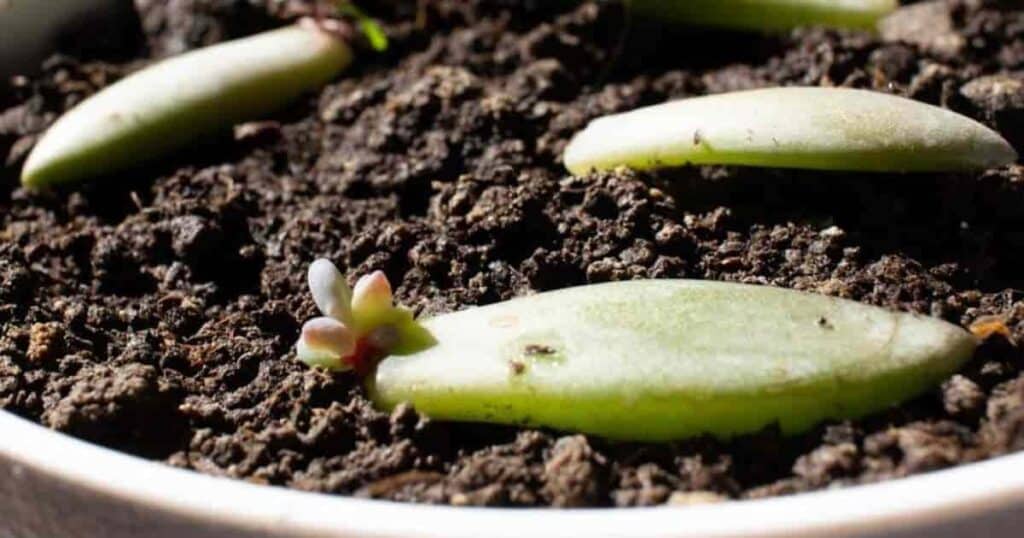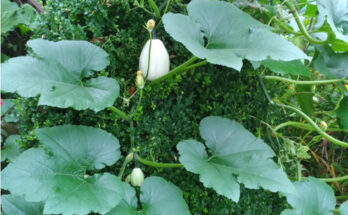Do you have a problem with succulent leaves falling off your plants? Fleshy-leaved succulents and cactus may often drop their leaves for a wide variety of reasons.

Falling leaves are a natural part of the growth process or a response to environmental stress, which may include circumstances such as:
- Reduction in Energy Needs
- Too Much or Too Little Water
- Excessive Light
- Chemical Shock
- Excessive Heat
- Excessive Cold
- Lack of Light
… and More.
In this article, we explore the many reasons why succulent leaves may be dropping from your plants and share advice to help you deal with this problem.
7 Reasons and Answers To Why Are My Succulent Leaves Falling Off
Below, we look at potential causes for succulent dropping leaves. There are many factors the can contribute to leaf loss:
- The types of succulents
- Care of succulents
- Type of soil
- Pots with drainage
- Temperatures and periods of heat
#1 – Temperature Irregularities
The majority of succulents thrive in very warm, dry areas. Dropping leaves is sometimes a natural response to extended periods of excessive heat or drought.
Even though fallen leaves are a normal coping mechanism, it’s not one you want in an attractive ornamental plant.
Succulents can start to drop their leaves if they’re kept in low-light conditions for too long.
The most common reason for brown or dark spots on the leaves of your succulents is sun damage or sunburn.
You can slowly increase the length of sun exposure over a period of a few weeks until your succulent is getting around six hours of bright and direct sunlight each day or about 12 hours of artificial light.
To prevent your succulents from becoming stressed by extreme heat, you should locate them in the light shade when kept outdoors during hot weather. If they look wilted or sunburned, either move them or place a shade cloth over them.
Indoors, keep your succulents away from windows a bit so they get plenty of bright indirect light but are not scorched by direct, magnified sunlight.
Conversely, succulents may also drop leaves and show other signs of stress when touched by frost.
Most succulents do not survive freezing weather and may develop burned black and falling leaves.
A plant stressed by frost but not killed will usually generate some new leaves to replace the damaged leaves.
It’s better to allow the damaged leaves to fall off naturally than to pull or prune them away. NOTE: Try starting some new plants with the leaves.
Plant cold-sensitive succulents in protected areas outdoors and mulch or cover in winter as appropriate for protection.
Keep indoor succulents away from areas (e.g., near exterior doors) where they might receive cold blasts of air during the winter months.
#2 – Lighting Excesses & Changes
Most succulents like the Echeveria plant, Aloes, and Haworthias do best with consistent, bright indirect lighting 6-8 hours a day.
When kept in a low light setting, your succulents lose color and may even turn yellow.
Related: Learn more about succulent leaves turning yellow.
Eventually, the leaves will fall off.
Other signs of excessively low lighting include stretching.
If your plant is leaning toward the light and creating long, spindly stems, it’s a sign you need to move the plant into a better-lit area.
The stem and the plant itself stretch out toward the direction of the light source.
Sudden changes in light can cause succulent plants to drop leaves. Watch how your plant reacts when moving to a different location or when using a grow light, or when making any sort of adjustments.
If you have had your plant oriented in one way toward the sun for a long time and then you suddenly turn it, this is often enough stress to cause leaf drop.
Likewise, if you move the plant from a relatively low-lit area to a very highly-lit area or vice versa, leaf loss may occur.
Be sure to make any changes gradually so your plant will have time to adapt.
#3 – Succulent Leaves Falling Off From Pests Can Also Be The Problem
Check out these links for more details:
#4 – Chemical Burns Can Cause Leaf Drop
Chemicals can shock your houseplant’s system and don’t have to be excessively harsh chemicals.
Even treatments for maladies, such as the fungus designed to use with succulents, can cause your plant to drop its leaves.
When treating your plant for any ailment, it’s wise to look for natural alternatives first.
Nutrients can be added in by re-potting the plant in a fresh potting mix or by fertilizing the plant.
If you must turn to chemical treatment, be sure to follow the packaging instructions very carefully.
Keep your plant in an ideal, consistent setting during treatment to avoid excessive stress.

#5 – Are You Watering Correctly?
Even though the vast majority of outdoor succulents are drought tolerant, a lack of water will naturally cause them to wilt and drop leaves.
By the same token, excess water can cause succulent leaves to swell up too much and fall off. Look for signs of root rot.
Rot in succulents can happen due to too much water, heavy potting mix that holds too much moisture, high humidity, heat (as discussed above), or frost.
Leaves that fall off from overwatering or underwatering appear wet and mushy, and the stem may appear puffy.
Pull off any dead leaves from the plant or remove dead leaves that have fallen off into the soil to prevent insects and bugs from hiding in there.
You must find the perfect medium to water your plants in just the right amount. As a rule of thumb, all succulent lovers must follow a regular watering schedule to prevent making the soil too damp.
You should wait until the soil is nearly dry and then water very thoroughly.
Related: How often should you water a succulent?
#6 – Is Your Succulent in the Right Kind of Container?
Containers for succulents and cacti should always be made of porous, breathable material such as terra-cotta or hypertufa, and they should always have plenty of drainage holes.
#7 Is Your Succulent in the Right Kind of Potting Soil?
Succulent plants need light, airy, well-draining soil. Succulent and cactus specialty soil is easy to find at any gardening center.
It’s also great to use a succulent pot with a drainage hole. This helps prevent overwatering as well. When you water, you should be able to pour the water through the soil and have it run freely through the ample drainage holes in the bottom of your container.
Related: How to make succulent soil!
#8 Is Your Plant Growing?
Sometimes as succulent plants grow taller, leaves falling off or naturally shedding their lower leaves is common. This is not a cause for alarm.
Succulent Care Is Easy
Consistency and moderation are the keys to successful succulent care.
- Be sure to provide your plant with enough light (without scorching it).
- Keep it consistently warm during the day, and don’t allow it to become excessively chilled at night.
- Provide a pot and potting soil allowing for good air circulation around the root system.
- Water seldom and thoroughly.
If you follow these guidelines, your succulent should only experience fallen leaves and leaf drops as a part of normal growth.
Source link
Originally posted 2023-10-06 18:53:31.





